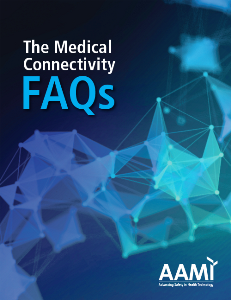Wireless Medical Telemetry Service
60. What is wireless medical telemetry?
Wireless medical telemetry is used to wirelessly monitor patients’ physiological data in real time and detect life-threatening events. Patients wear wireless sensors that send real-time physiological data to a computer, which allows clinicians to monitor patients’ conditions and detect events that require prompt intervention (e.g., cardiac arrhythmias).
61. What is the Wireless Medical Telemetry Service (WMTS)?
The FCC “allocated new spectrum and established rules for a Wireless Medical Telemetry Service (WMTS) that allows potentially life-critical equipment to operate on an interference-protected basis.”40 FCC 00-211 created the WMTS as a licensed-by-rule service that allows hospitals around the country to use these frequency bands for medical telemetry: 608–614 MHz (TV channel 37), and 1395–1400 MHz and 1427–1432 MHz (the L-band)*, and notes that “these bands each have significant constraints, such that the entire allocation is unlikely to be available in any individual market.”41
* There are some minor geographical modifications to the exact L-band frequencies.
62. Why was the WMTS created?
The WMTS was created after an incident at Baylor University Medical Center in March of 1998. A dozen telemetry monitors suddenly stopped working due to a new DTV station that came online and operated in the same frequency band as the telemetry monitors. Please refer to this article, written by The New York Times.42
63. What does licensed spectrum mean?
Licensed spectrum is a band of radio frequencies in which licensees are legally entitled to operate free from interference from lower-status (e.g., unlicensed) users. See the FCC licensing web page.43
64. Does medical telemetry operating in the 608–614 MHz band experience interference now?
The root cause of interference for medical telemetry operating in the 608–614 MHz band has typically been due to one of the following reasons:
- Two or more WTMS devices operating in the hospital (e.g., one ward was not aware of another ward’s WMTS devices).
- Adjacent-channel interference from local DTV, which was anticipated in the rulemaking that created the WMTS.
- A variety of in-hospital sources (including noisy motors in floor polishers [buffer problem], metal gurney rolling past a receiving antenna, CT scanners, and faulty fluorescent ballasts) have caused unintentional interference to telemetry systems that have no ability to confirm proper receipt of that data by the receiver, i.e., acknowledgments.44
65. What is the FCC 600 MHz incentive auction?
As part of the Middle Class Tax Relief and Job Creation Act of 2012, Congress required that the FCC repurpose and auction spectrum for commercial use (Section 6403 of the Act). The 608–614 MHz band of the WMTS is included in that law; the 1.4 GHz band of the WMTS is not. Since remaining DTV stations will be more optimally repacked into less spectrum, the eventual effect of the auction will be a more tightly spaced and more efficiently used broadcast band than we currently have; but this results in less “white space” between broadcasters for unlicensed use. To help appease supporters of unlicensed white space operations in the UHF band, the FCC proposed and adopted a sharing regime between medical telemetry and unlicensed operations in the 608–614 MHz band.
66. How did the FCC incentive auction impact devices operating in the WMTS and does it impact the 1.4 GHz WMTS bands?
The FCC revised its rules in 2015 to allow unlicensed TV white space (TVWS) to operate in WMTS 608–614 MHz band (TV channel 37), assuming the unlicensed TVWS devices stay a minimum distance from the hospital. In other words, each hospital should have a protective bubble around it where unlicensed TVWS devices are not allowed to operate on channel 37. The current rules do not guarantee that medical devices will NOT experience interference (e.g., the bubble is not big enough). Tests performed using real hospital WMTS systems have shown that interference can occur when unlicensed TVWS devices are within 2 km, whereas the FCC’s rules allow such devices to operate within 350 m. Telemetry systems operating in the 608–614 MHz band depend on a noise-free environment to receive signals reliably. In the presence of interference, where the spectrum is not quiet, they experience data loss during patient monitoring.
The FCC incentive auction does not affect the 1.4 GHz channels of the WMTS.
67. How can hospitals respond to interference?
The FCC’s current rules put the burden on the hospital to identify interference and file a waiver to increase the distance that applies to a facility. While investigating the source of interference and waiting for a waiver to be approved, the hospital must find alternate ways to monitor patients. By monitoring system performance, the hospital identifies an increased rate of interference, perhaps by observing physiological data dropout at the central monitoring station. The hospital investigates the source of the interference, which requires specialized experience and tools. If the source of interference is internal (e.g., another hospital ward using the same channels, a noisy motor, or a failing fluorescent light ballast), address the problem internally. If the problem is due to a TVWS device, file a waiver.
In the FCC report and order that created the WMTS, the FCC allocated 14 MHz (more than the 12 MHz of bandwidth than the American Hospital Association requested). The FCC also wrote, “We wish to underscore that we do not anticipate any further allocations for medical telemetry devices and expect manufacturers and the health care community to ensure that this spectrum is used efficiently to meet long term needs.”41 Viewed from another perspective, allocating the 2.4 GHz band for WMTS would require displacing several billion-dollar industries comprising Wi-Fi, Bluetooth, Zigbee, cordless phones, baby monitors, and other radios. It is worth noting that several physical layers that operate in the 2.4 GHz band support medical devices and medical telemetry. Finally, the 2.4 GHz band is an ISM band, which is reserved internationally.

